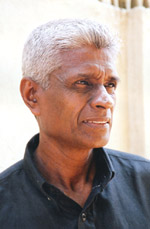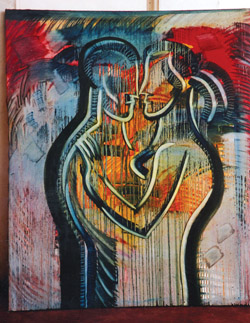The art of S. H. Sarath
Ashley Halpe
ART: The art of S. H. Sarath has a special and important place in the
art of Sri Lanka.
|

ARTIST: S. H. Sarath
|
The contemporary art of this country is defined by diversity and
animated by a restless, experimental search for authenticity of
aesthetic utterance. Though quite conversant with the vocabulary and the
experiences of modernism, it can more accurately be called post-modern.
Its practitioners characteristically insist on response to a riven
reality and fractured consciousness, but intensely focused meditation
and decorative exuberance have also found niches in our contemporary art
scene.
There is, thus, considerable point in the statement by leading artist
and art educator Jagath Weerasinghe that "the post-colonial historical
condition is such that it has made us inhabit, quite cheerfully, and a
historical social space. Contemporary Sri Lankan art is an expression of
this social, political and cultural condition."
Contemporary art in Sri Lanka does not usually reflect or share in,
the commonality of wider social intuitions that informs art expression
and experience within the ambience of a living tradition.
There has been a deep-going and crucial divergence from tradition:
between the monumental sculptures of the Anuradhapura period or the
temple painting of the Kandyan period and the modern studio artist's
treatment of a Buddhist theme there is very nearly an absolute gulf.
Dynamism
George Keyt was different in being creatively alive to the past to
achieve a dynamism that was, at the same time, quite modern. However,
the past he most relates to is that of Hindu India (the striking
exception being his murals at the Gothami Vihara).
It is in this context that the art of S. H. Sarath has special
importance. His artistic vocabulary has been formed by a rich fusion of
the traditional and the contemporary.
|

COUPLE: A modernistic painting
|
Daring juxtapositions of colour areas in and the around figures which
have fractured forms and been subjected to subtle torsions, and the
frequent use of minuscule brush strokes somewhat reminiscent of
pointillism suggest Sarath's absorption of modernist practice.
At the same time, equally typical of his art is the use of fluid line
and curvilinear motifs which remind us of traditional motifs of Sinhala
art such as the liyavela (creeper and creeper/woman) and ginidalu
(flame) motifs.
His Lovers series illustrates this marriage of styles very well.
Particularly striking is a painting in which an incandescence flames
behind the lovers, but there are many other creative inventions. In
another set torsos appear in extraordinary combinations or a female face
is set above an inverted male face and a male lower body.
Sarath's concern with the human condition and in particular his
humane yet unsparing concern for our suffering country finds its most
cogent expressions in his black and white work.
Bleak landscapes feature disorted forms or surreal combinations of
faces, animal forms and twisted vegetation. The guardians of Hell give
themselves immunization shots against viruses carried by Sri Lankan
politicians entering their domain. Face is a composite of Lankan visages
all yearning for the samething - Peace.
Devils
A snake swallows the freedom of the Lankan press; Lankans of all
kinds climb greasy poles to reach meagre meals set atop them while Sri
Lankan politicians are feasted sumptuously by devils.
The chaos of Sri Lankan values is presented by Lankans being depicted
as welcoming with equal enthusiasm the Bodhi seedling carried by the
Enlightened One's disciples and the tea bush carried by (comically
represented) imperialists.
The impartiality of his political vision is shown by his giving us
both Face 2 depicting the sufferings of the Jaffna people and the
imaging of the Buddha cutting off his hair as a cutting of a top-knot in
the shape of the Jaffna Peninsula.
This ranging from the expression of intensely inventive creative
imagery to the incorporation of traditional motifs as well as the
juxtaposition of works of humane concern with the images of a richly
creative plastic and chromatic imagination entitle Sarath to a place of
honour in any account of the art of Sri Lanka.
The art of S. H. Sarath can be viewed at his private gallery at 18A,
Sarasavi Udyanaya, Nawala Road, Nugegoda. |

